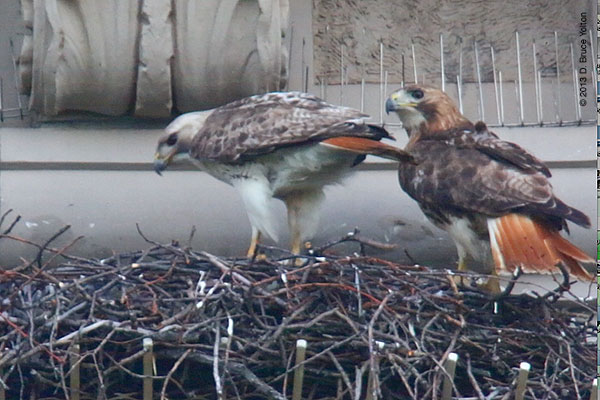Central and Morningside Parks 2015
I’m looking forward to the 2015 Red-tailed Hawk nest hatches in Central and Morningside Parks. We have three confirmed nests in Central Park, a pair seen frequently in the NE section of the Central Park, and our Cathedral hawks have a new nest location exposed to the elements.
With any new season, I look forward to discovering new aspects of urban Red-tailed Hawk behavior.
Three Central Park nests is fantastic news this year. But one has to wonder about locations and why these three nests are so close together? Do these three Red-tailed hawk pairs benefit by having protected flanks from the other pairs? Does this outweigh any issues over food contention, etc.? Or did the new nest locations have nothing to do with the other nest locations? It will be interesting to see when other raptor species fly over the park, if the Red-tailed Hawks work together to escort them away. And which pair will tale over the Locust Grove.
The Beresford Apartment nest will have new fledglings who will have to cross Central Park West to end up in Central Park or maybe even Teddy Roosevelt Park. Which buildings will they perch on the first few weeks? The Museum of Natural History? Or like many Red-tails, will they try to get as high as possible the first week and end up back on the Beresford? Where will the parents take them to hunt? South to the calm lawn south of The Yard? Or up North?
How will the exposed nest do at the Cathedral of Saint John? Will it be as productive as St. Andrew had been?
And is there a forth pair nesting near the park? Almost all of the experienced hawk watchers in Central Park saw a pair of hawks all winter around the Conservatory Garden. In April, many of us have seen a single hawk in the park, who flies over to Madison Avenue between 100th to 106th. Is there a nest tucked away a block from the park or in the public housing east of Madison?
I’m looking forward to learning more about Red-tailed Hawks this season. How fantastic is it that one of the best places to study Red-tailed Hawks is in the middle of Big Apple! New York City truly is one hell of a town.











































